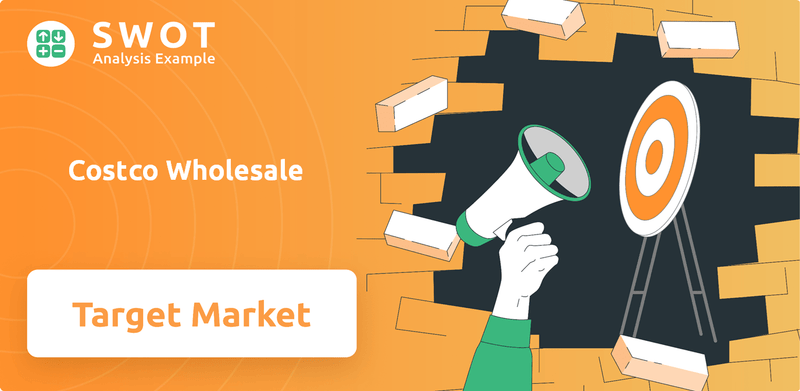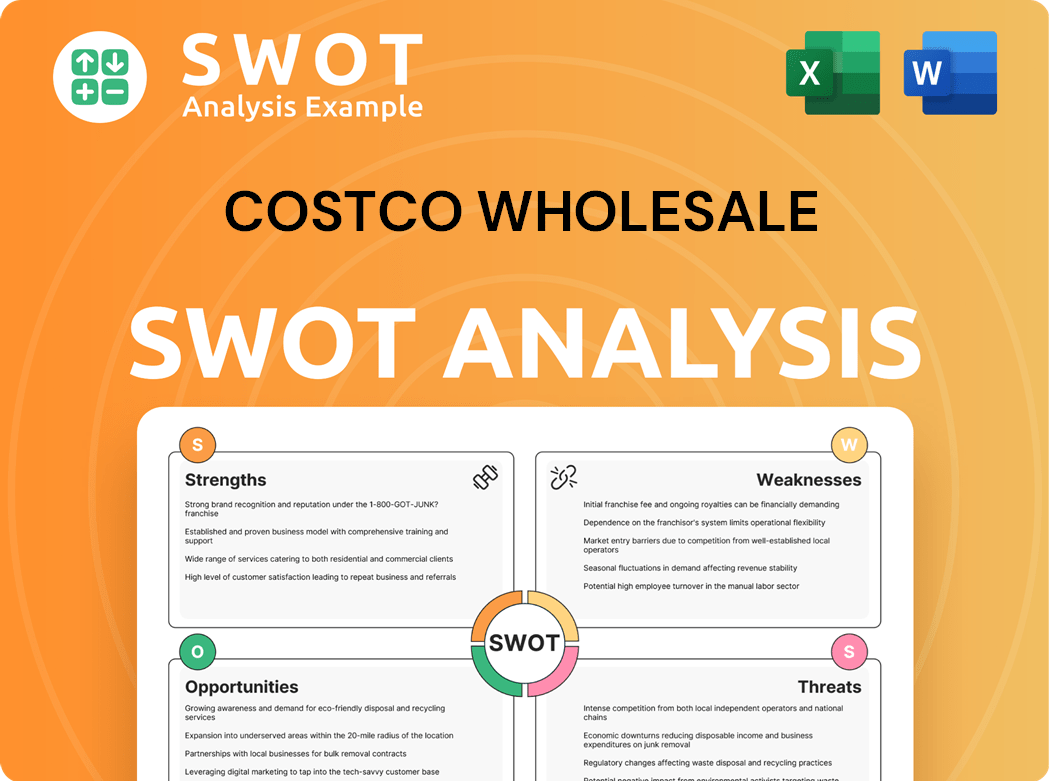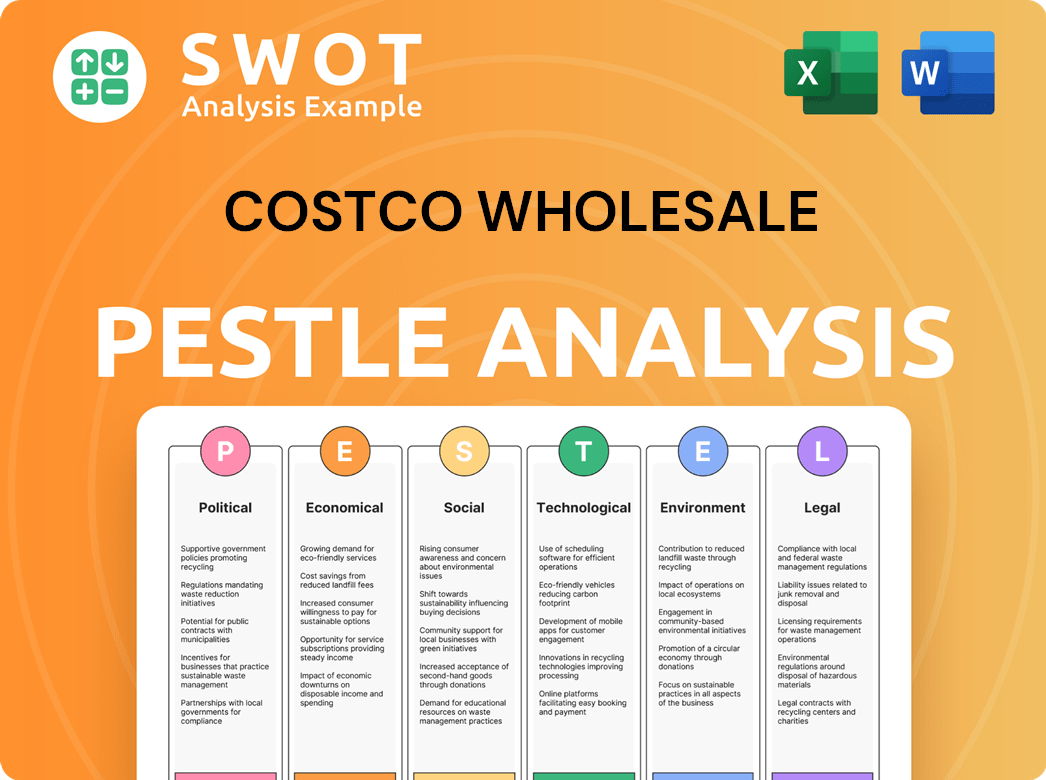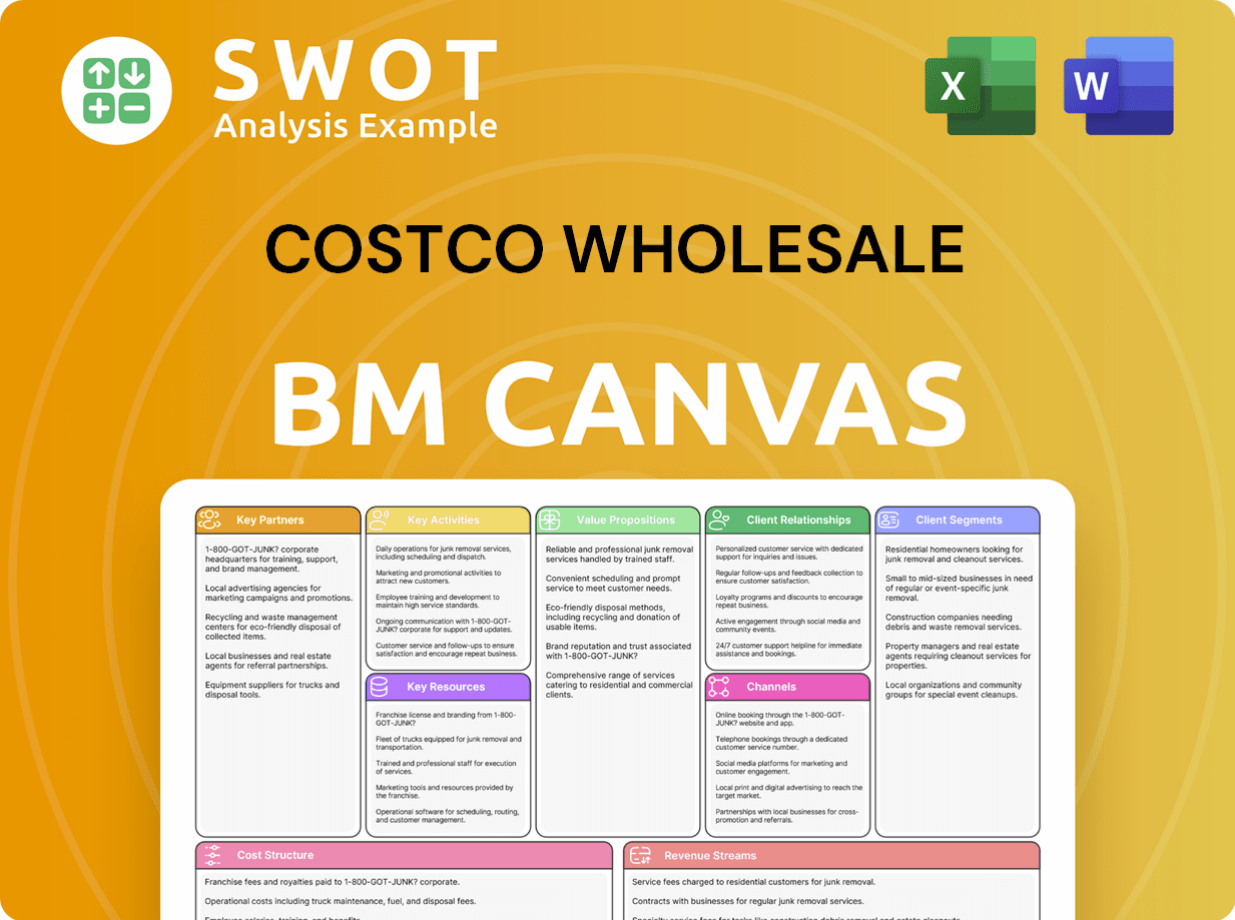Costco Wholesale Bundle
Who Are Costco's Loyal Customers?
Costco Wholesale, a retail giant since 1983, has built a business empire on understanding its customer base. From its early days serving businesses to its current status as a membership-driven warehouse club, Costco's success hinges on knowing who shops there and why. The company's evolution reflects a keen awareness of changing consumer behaviors and market trends, especially since January 2024.

This exploration delves into the Costco Wholesale SWOT Analysis to uncover the core of Costco's customer base, examining customer demographics Costco, Costco target market, and Costco customer profile. We'll analyze Costco membership demographics, including Costco shoppers' income levels, age range, and buying habits to understand their preferences for Costco wholesale products. This analysis will provide actionable insights for investors and business strategists alike.
Who Are Costco Wholesale’s Main Customers?
Understanding the Growth Strategy of Costco Wholesale involves a deep dive into its customer base. Historically, the primary customer segments have been characterized by affluent, educated, and family-oriented individuals. However, the landscape is evolving, with a noticeable shift towards a younger, more tech-savvy demographic. This evolution is crucial for the company's continued success.
As of 2024, the company boasted a global membership of 136.8 million, marking a 6.96% increase from the previous year. This growth underscores the broadening appeal of its offerings. The company adeptly serves both consumers (B2C) and businesses (B2B), creating a diverse and robust customer ecosystem.
The typical Costco customer profile in 2025 is often between 35 and 60 years old, with roughly 90% of members falling within this age bracket. The company's ability to cater to a wide age range is a key factor in its sustained success. The membership demographics reflect a diverse and evolving consumer base.
The Costco customer age range is primarily between 35 and 60 years old. Approximately 33% of members are aged 35-44, 29% are aged 45-54, and 27% are aged 55-64. This indicates a core group of middle-aged shoppers, although the average age has decreased.
A significant portion, around 46%, of Costco shoppers falls into the middle-income category. The median household income is approximately $92,236, exceeding the national median. A substantial segment earns between $75,000 and $150,000 annually, reflecting the financial profile of the customer base.
Approximately 37.5% of Costco customer profile holds a bachelor's degree or higher, indicating a well-educated customer base. In terms of gender, females constitute 53.70% of customers, while males represent 46.30%, showing a slight female skew.
Executive members, who pay double the base membership fee, are particularly valuable, accounting for 73% of its $250 billion global net sales in 2024. This segment grew nearly 10% in fiscal 2024 to 35.4 million members. Over half of new members are now under 40 years old, indicating a shift towards a younger demographic.
The Costco target market includes both consumers and businesses, with a strong emphasis on value and bulk purchasing. The company's success is rooted in understanding and catering to these diverse segments. The company's warehouse model also caters to small and medium businesses for bulk orders.
- Affluent, educated individuals and families.
- Middle-income earners with a median household income of approximately $92,236.
- Consumers aged 35-60, with a growing segment of younger members.
- Businesses seeking bulk purchasing options.
Costco Wholesale SWOT Analysis
- Complete SWOT Breakdown
- Fully Customizable
- Editable in Excel & Word
- Professional Formatting
- Investor-Ready Format

What Do Costco Wholesale’s Customers Want?
Understanding the needs and preferences of its customer base is crucial for the success of any business. For Costco, this understanding is at the core of its business model. The company's focus on value, quality, and a unique shopping experience has cultivated a loyal customer base. This approach helps the company to maintain its competitive edge in the retail market.
Costco's customers are primarily driven by a value-oriented mindset. They seek high-quality products at discounted prices, including both premium brands and the company's private-label Kirkland Signature line. The appeal of bulk buying is a significant motivator, allowing customers to stock up on larger quantities and realize lower unit prices. This makes it attractive to large families and budget-conscious consumers. The company's strategy has proven successful, with customers visiting approximately 30 times per year, spending an average of $100 to $150 per trip.
Beyond tangible savings, the company's 'treasure hunt' layout encourages browsing and the discovery of unexpected deals on items like electronics or seasonal goods. This creates a unique and engaging shopping experience that fosters repeat visits. Brand consciousness is also a key preference, with shoppers seeking both well-known national brands and the value offered by Kirkland Signature. This blend of factors contributes to the strong customer loyalty that the company enjoys.
The company's customers prioritize value, seeking high-quality products at discounted prices. This includes both well-known brands and the Kirkland Signature line. The bulk-buying model allows for lower unit prices, appealing to budget-conscious consumers.
Customers are drawn to the opportunity to purchase items in bulk, which leads to lower unit prices. This is particularly attractive to families and individuals who want to stock up on essential goods. This encourages customers to shop more frequently.
The store layout encourages browsing and the discovery of unexpected deals. This creates an engaging shopping experience that fosters repeat visits. The 'treasure hunt' aspect keeps customers coming back to see what's new.
Shoppers seek both well-known national brands and the value offered by the Kirkland Signature line. This combination of brand recognition and private-label options caters to a wide range of preferences. This approach builds trust and loyalty.
The company addresses customer needs by providing competitive pricing, often capping product markups at 15%. This is well below the industry average. This strategy ensures that customers perceive the company as offering good value.
The company's efficient distribution strategy, including direct shipping from suppliers, reduces costs. This optimizes the supply chain, passing savings to members. This efficiency contributes to the company's ability to offer competitive prices.
The company tailors its offerings to meet the evolving needs of its customer base, including an increasing focus on health and wellness items, smart home devices, and premium outdoor gear. This adaptability helps the company stay relevant and appealing to its customers.
- Customer feedback and market trends heavily influence product development, ensuring that the company is consistently meeting customer needs.
- The company focuses on optimizing member value and expanding the Kirkland Signature brand, which resonates with customers seeking quality at competitive prices.
- There's been a shift in spending from food away from home to food at home, leading to strong meat and produce sales, including premium cuts and lower-priced options.
- The company's commitment to providing value and adapting to customer preferences is evident in its product selection and pricing strategies.
The company’s success is also reflected in its customer loyalty. The company's focus on value and a unique shopping experience has cultivated a loyal customer base. To learn more about the company's journey, consider reading about the Brief History of Costco Wholesale.
Costco Wholesale PESTLE Analysis
- Covers All 6 PESTLE Categories
- No Research Needed – Save Hours of Work
- Built by Experts, Trusted by Consultants
- Instant Download, Ready to Use
- 100% Editable, Fully Customizable

Where does Costco Wholesale operate?
As of May 2025, the company boasts a significant global presence, operating a total of 905 warehouses worldwide. Its operations are strategically spread across multiple countries, with a strong focus on North America, which continues to be its primary market. This widespread geographical distribution is a key factor in its business strategy, allowing it to reach a diverse range of customers.
The company's largest market remains the United States, where it operates 624 warehouses, including Puerto Rico. Canada is another significant market with 109 locations. Mexico also plays a crucial role, with 41 warehouses contributing to its North American presence. In fiscal year 2024, North America accounted for approximately 75% of the company's revenue, highlighting the importance of this region to its overall financial performance.
Beyond North America, the company has a growing international footprint. It has expanded its presence in various countries, including Japan (37 warehouses), the United Kingdom (29), South Korea (19), Australia (15), Taiwan (14), China (7), Spain (5), France (2), and one each in Iceland, New Zealand, and Sweden. This global expansion strategy helps diversify its revenue streams and mitigate risks associated with relying on a single market.
The company actively pursues a strategy of opening new warehouses to expand its market reach and serve more customers. In fiscal year 2025, it plans to open 29 new locations, including 23 in the U.S. and 6 internationally. This growth demonstrates its commitment to increasing its presence in both existing and new markets.
Geographical diversification helps the company to buffer against localized economic downturns and ensures a broad revenue base. By spreading its operations across multiple regions, it reduces its reliance on any single market. This strategy supports long-term growth and stability.
The company tailors its offerings and marketing strategies to suit the specific needs and preferences of each market. Its global buying staff focuses on delivering increased everyday value to members by offering quality products at the lowest possible prices. This approach ensures it remains competitive and appealing to diverse customer segments.
The company also operates e-commerce sites in several regions, including the U.S., Canada, the U.K., Mexico, Korea, Taiwan, Japan, and Australia. This online presence complements its physical stores, providing customers with additional options for shopping and further expanding its market reach.
Recent and upcoming expansions in 2025 include new stores in various U.S. cities like Brentwood, Highland, Prosper, Weatherford, Genesee County, Sharon, Stuart, and Midland, Texas. Internationally, new locations are planned for Minami Alps (Japan), Ardeer (Australia), Pyeongtaek (South Korea), and Malmö (Sweden). For more insights into the company's business model and customer base, you can read an article about the company's customer demographics and target market.
Costco Wholesale Business Model Canvas
- Complete 9-Block Business Model Canvas
- Effortlessly Communicate Your Business Strategy
- Investor-Ready BMC Format
- 100% Editable and Customizable
- Clear and Structured Layout

How Does Costco Wholesale Win & Keep Customers?
The success of Costco Wholesale hinges on its effective customer acquisition and retention strategies, deeply rooted in its membership-based model. This approach creates a strong barrier to entry, fostering customer loyalty and driving consistent revenue. As of 2024, Costco boasted a global membership base of 136.8 million members, demonstrating significant growth and the enduring appeal of its value proposition.
Costco’s customer acquisition strategies are primarily driven by word-of-mouth marketing and member referrals, complemented by targeted digital and traditional marketing initiatives. The company focuses on offering special discounts and limited-time promotions to attract new customers and engage existing ones. Data analytics and feedback analysis play a crucial role in tailoring offerings and communications to meet member needs effectively.
To retain its members, Costco leverages exclusive events and member benefits, creating a strong sense of community. The Executive Membership, with its 2% cashback reward, incentivizes continued patronage. Furthermore, Costco has been adapting to the digital landscape, enhancing its online services and investing in technology to improve the overall member experience. These strategies contribute to the company's high customer retention rates and sustained growth.
Costco relies heavily on word-of-mouth and member referrals to attract new customers. It also uses direct marketing through emails and sales promotions. The company utilizes data analytics to understand customer preferences and tailor its offerings.
The membership model is a core element of Costco's strategy, creating a barrier to entry. There are two main membership tiers: Gold Star and Executive. This model fosters customer loyalty and drives recurring revenue.
Costco enhances member retention through exclusive events and benefits. The Executive Membership offers a 2% cashback reward. The company is also investing in technology and online services.
Costco is expanding its e-commerce capabilities to cater to tech-savvy consumers. E-commerce sales grew by 20.7% compared to last year. The company focuses on enhancing the member experience.
Costco's customer retention is notably strong, with the U.S. and Canada membership renewal rate reaching 92.7% in 2024, and a worldwide rate of 90.5% as of Q2 2025. Despite a membership fee increase in September 2024, membership numbers still increased by almost 8% year-over-year in Q1 fiscal 2025, with executive member renewal rates at 91%. This demonstrates the enduring value proposition of the membership, which includes lower prices and exclusive access. For more insights into Costco's business model, consider exploring the Revenue Streams & Business Model of Costco Wholesale.
Costco Wholesale Porter's Five Forces Analysis
- Covers All 5 Competitive Forces in Detail
- Structured for Consultants, Students, and Founders
- 100% Editable in Microsoft Word & Excel
- Instant Digital Download – Use Immediately
- Compatible with Mac & PC – Fully Unlocked

Related Blogs
- What are Mission Vision & Core Values of Costco Wholesale Company?
- What is Competitive Landscape of Costco Wholesale Company?
- What is Growth Strategy and Future Prospects of Costco Wholesale Company?
- How Does Costco Wholesale Company Work?
- What is Sales and Marketing Strategy of Costco Wholesale Company?
- What is Brief History of Costco Wholesale Company?
- Who Owns Costco Wholesale Company?
Disclaimer
All information, articles, and product details provided on this website are for general informational and educational purposes only. We do not claim any ownership over, nor do we intend to infringe upon, any trademarks, copyrights, logos, brand names, or other intellectual property mentioned or depicted on this site. Such intellectual property remains the property of its respective owners, and any references here are made solely for identification or informational purposes, without implying any affiliation, endorsement, or partnership.
We make no representations or warranties, express or implied, regarding the accuracy, completeness, or suitability of any content or products presented. Nothing on this website should be construed as legal, tax, investment, financial, medical, or other professional advice. In addition, no part of this site—including articles or product references—constitutes a solicitation, recommendation, endorsement, advertisement, or offer to buy or sell any securities, franchises, or other financial instruments, particularly in jurisdictions where such activity would be unlawful.
All content is of a general nature and may not address the specific circumstances of any individual or entity. It is not a substitute for professional advice or services. Any actions you take based on the information provided here are strictly at your own risk. You accept full responsibility for any decisions or outcomes arising from your use of this website and agree to release us from any liability in connection with your use of, or reliance upon, the content or products found herein.